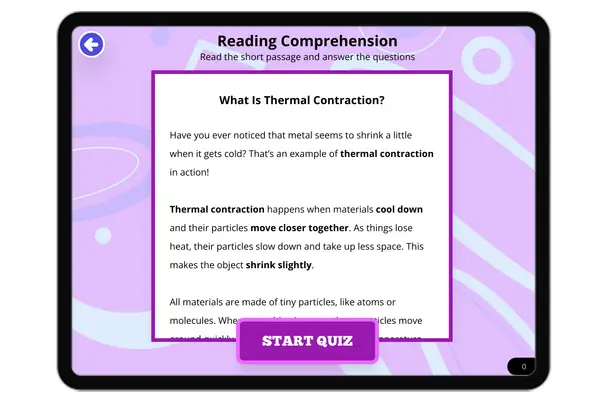Understanding Mechanical Energy — Passage
Mechanical energy is the energy an object has because of its motion or position. It is the sum of two types of energy: kinetic energy and potential energy. Kinetic energy is the energy of motion. For example, a moving car, a rolling ball, or a person running all have kinetic energy. The faster something moves, the more kinetic energy it has.
Potential energy is stored energy. This energy comes from an object's position or condition. For instance, when you lift a rock above the ground, it has potential energy due to gravity. The higher you lift it, the more potential energy it gains. If you let go, the potential energy turns into kinetic energy as the rock falls.
Mechanical energy can change from one form to another. A good example is a swinging pendulum. When the pendulum is at its highest point, it has maximum potential energy. As it swings down, that energy turns into kinetic energy. At the bottom of the swing, kinetic energy is at its highest. Then, as it moves upward again, kinetic energy becomes potential energy.
Mechanical energy is important in everyday life. It helps machines work, allows people to move, and plays a role in sports, transportation, and building construction. Understanding how mechanical energy works can help us design better tools and use energy more efficiently.
Fun Fact: A hammer uses mechanical energy every time you swing it—your motion provides kinetic energy, and the height of the hammer adds potential energy before impact!
What are the two types of mechanical energy?
Heat and lightKinetic and potentialElectrical and thermalSound and gravitationalWhat kind of energy does a moving object have?
Potential energyNuclear energyChemical energyKinetic energyWhen you lift a rock, it gains energy because of its...
SpeedTemperaturePositionShapeWhat happens when potential energy is released?
It disappearsIt becomes kinetic energyIt freezesIt becomes soundWhich of these best shows mechanical energy at work?
A battery storing powerA microwave heating foodA soccer player kicking a ballA book sitting on a tableWhat happens at the lowest point of a swinging pendulum?
It has no energyIt has the most potential energyIt has the most kinetic energyIt stops movingWhat does the passage mainly explain?
How machines are builtWhy energy is invisibleThe forms and uses of mechanical energyThe history of mechanical energyWhich of the following is TRUE based on the passage?
Mechanical energy only exists in machinesEnergy cannot change formsPotential energy increases as height increasesKinetic energy is stored energy










